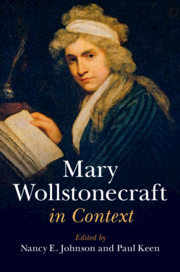Book contents
- Mary Wollstonecraft in Context
- Mary Wollstonecraft in Context
- Copyright page
- Contents
- Illustrations
- Notes on Contributors
- Preface
- Frontispiece
- Chronology
- Part I Life and Works
- Part II Critical Fortunes
- Part III Historical and Cultural Contexts
- The French Revolution Debate
- The Rights of Woman Debate
- Philosophical Frameworks
- Legal and Social Culture
- Literature
- Chapter 30 Sentimentalism and Sensibility
- Chapter 31 English Jacobin Novels
- Chapter 32 Anti-Jacobin Novels
- Chapter 33 Children’s Literature
- Chapter 34 Gothic Literature
- Chapter 35 Travel Writing
- Chapter 36 History Writing
- Chapter 37 Periodicals
- Chapter 38 Translations
- Suggested Further Reading
- Index
Chapter 34 - Gothic Literature
from Literature
Published online by Cambridge University Press: 16 January 2020
- Mary Wollstonecraft in Context
- Mary Wollstonecraft in Context
- Copyright page
- Contents
- Illustrations
- Notes on Contributors
- Preface
- Frontispiece
- Chronology
- Part I Life and Works
- Part II Critical Fortunes
- Part III Historical and Cultural Contexts
- The French Revolution Debate
- The Rights of Woman Debate
- Philosophical Frameworks
- Legal and Social Culture
- Literature
- Chapter 30 Sentimentalism and Sensibility
- Chapter 31 English Jacobin Novels
- Chapter 32 Anti-Jacobin Novels
- Chapter 33 Children’s Literature
- Chapter 34 Gothic Literature
- Chapter 35 Travel Writing
- Chapter 36 History Writing
- Chapter 37 Periodicals
- Chapter 38 Translations
- Suggested Further Reading
- Index
Summary
For Mary Wollstonecraft, the word “gothic” would not have denoted a kind of literature, let alone a mode or genre. At best, it would have signaled an architectural style and the epoch and people who produced it. Literally denoting “of the Goths,” the word signified “medieval,” perhaps vaguely “barbarous”: at once “not classical” and “not modern.” It also carried political connotations, thanks to the widespread belief that the ancient Goths were the same Germanic invaders who had settled in England during the late Roman Empire. Synonymous with nativist associations of pre-Norman England, it could be associated with various Saxon traits of inclusiveness, fairness, vigor, and forthrightness. Students of popular culture already will have a notion how such a rich yet opaque term could come, with time, to denote a literature. And once established, Gothic’s blend of historical fantasy, uncanny phenomena, sexual danger, and extreme situations has never left us.
- Type
- Chapter
- Information
- Mary Wollstonecraft in Context , pp. 289 - 296Publisher: Cambridge University PressPrint publication year: 2020



